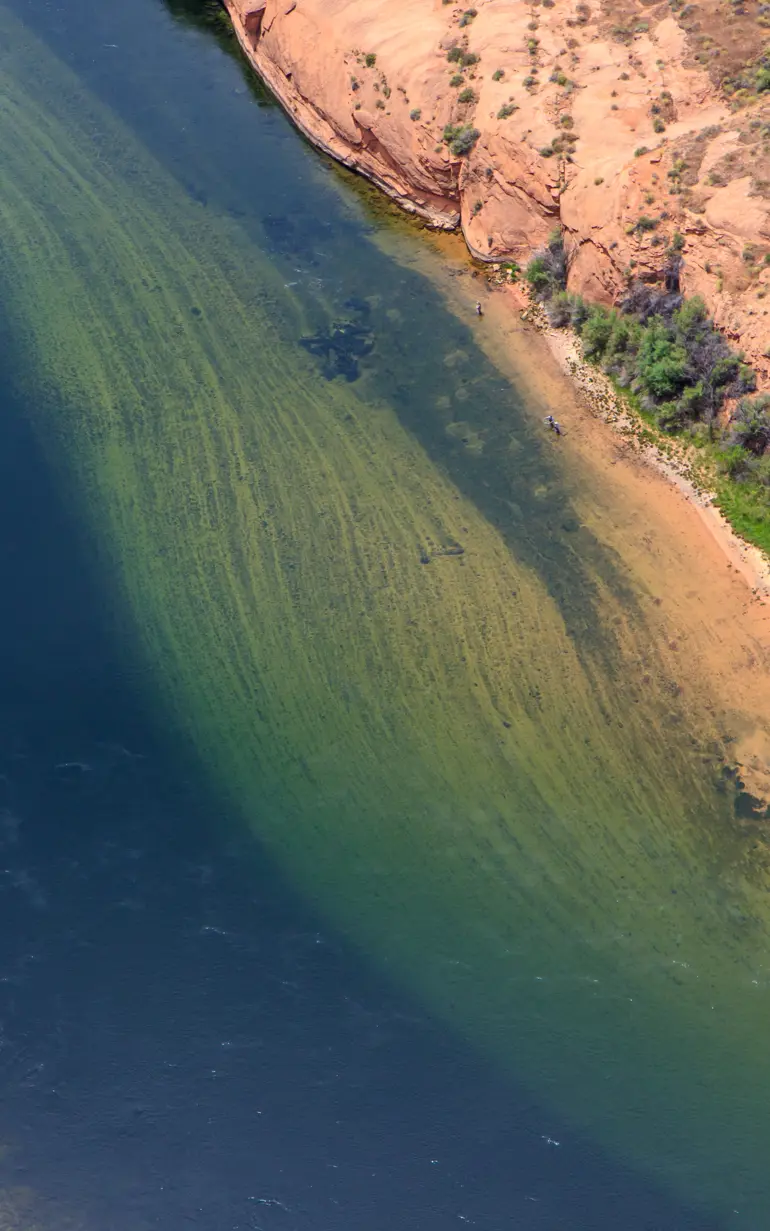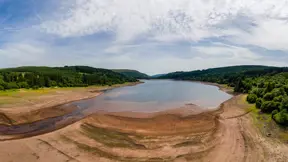

MIKE 21 Curvilinear Flow Model
Conduct advanced studies of river dynamics, focusing on sediment transport and morphology
MIKE 21 Curvilinear Flow Model (MIKE 21C) is powerful river morphology modelling software designed to transform complex river dynamics into comprehensive, actionable insights for teams and organizations. By integrating modules for hydrodynamics and sediment transport, this software ensures a holistic approach to river studies, supporting your decisions with accurate data on scour, deposition, and bank erosion.
Perfect for river engineers, environmental consultants, and flood risk managers, MIKE 21C includes features designed to predict changes over various time scales. By also accommodating complex sediment mixes, MIKE 21C helps you design safer, more efficient waterways.
How does MIKE 21C help?
No in-house modellers?
Get our expert modellers on board for your consulting projects either as a partner, to provide extended user support, or for model and project reviews. Submit an inquiry
Areas of application

Ecological restoration projects
Enhance restoration efforts by modelling river and coastal sediment dynamics alongside vegetation.

Erosion control measures
Design erosion control measures using complex sediment and hydraulic models to protect landscapes and manage shoaling.

Sediment transport and morphology
Analyse morphological changes in rivers and coasts by predicting changes in dynamic environments like braided rivers.
Additional capabilities & unique features
Explore our latest support resources, including guides, videos, and FAQs in our Knowledge Base.
Make long-term calculations of flow hydrodynamics with the Hydrodynamic (HD) module
With the MIKE 21C Hydrodynamic (HD) module, you can calculate flow fields in response to a variety of forcing functions, such as prescribed water levels or flows at open model boundaries.
- Compute water levels and flow velocities on a curvilinear or rectangular grid covering the study area by solving the St. Venant equations
- Perform long-term simulations with the highly efficient model solver
- Model hydraulic structures with your choice of dynamic or quasi-steady solutions
Understand the effect of helical flow on sediment movement and morphology in river bends
With MIKE 21C’s specialised Helical Flow module, you can accurately describe the time and space lag in the development of the helical flow to analyse bend scour, confluence scour and char build-up and migration. Helical flow develops in channel bends due to curved streamlines. While it generally does not have a strong influence on general flow patterns in rivers with large width/depth ratios, it can have a significant influence on sediment transport direction and hence morphological changes (e.g. sand bars).
Perform advanced sediment transport modeling (cohesive mud, non-cohesive sand & mixed sediments)
With MIKE 21C’s comprehensive Sediment Transport (ST) module designed for sediment transport and river morphology dynamics, you can model:
- Helical flow, bank erosion, bed scour
- Sediment transport for sand and gravel
- Bed load with secondary flow effects
- Suspended load with non-uniform concentration profile variation
- Multiple sediment fractions using cohesive and non-cohesive sediment models
- Individual sediment fractions for highly customisable parameterisation
Single fraction sediment models suffice in cases where the standard deviation of the particle size distribution is sufficiently low. The classic case being a low land river with well mixed sand, and it involves using e.g. the median grain size.
Graded sediment models are required for situations where the sediment cannot be described with one single size class. For such models, a number of discrete sizes are defined, which represent the known grain sizes involved in the considered problem. MIKE 21C supports up to 32 sediment fractions and up to 16 bed layers. Graded sediment models are far more complex than single fraction models, requiring:
- Sediment budget for each size class, e.g. distribute total sediment inflows to the fractions
- Local distribution of size classes in the bed, can include vertical distribution in the bed
- Sediment transport models can be defined individually for each size class
Compute scour and deposition to understand the large-scale movement of bed material
With MIKE 21C, you can accurately calculate scour and deposition including the effect of supply-limited sediment layers. Simulate the downstream migration of fine material on a coarse riverbed or represent non-erodible (protected) riverbed areas in the modelling domain.
Analyse bank erosion and planform changes
The Planform module of MIKE 21C allows you to accurately represent lateral processes in morphological models. Calculate bank erosion for inclusion in the riverbed sediment budget or update the curvilinear grid to account for movement in the bank line. You can also reproduce the chaotic behaviour of a multi-channel river such as a braided river.
Simulate the transport of mud, debris and oil
The Mud, Debris or Oil feature enables an alternative hydrodynamic solution in which a fluid dependent flow resistance is added to the standard flow momentum equations. This module can be used to study tailings dam breaks, flows with very high sediment concentrations and depth-integrated laminar flows, e.g. oil.
The rheological properties of non-Newtonian fluid, e.g. Bingham, are driven by the complex interaction of a fluid’s chemical and material composition. Key composition properties include the particle size distribution (e.g. percent fines), solids concentration, water content, chemical composition, and mineralogy such as the presence of clay minerals. The Bingham rheological model is well suited for homogenous fluid mixtures with high concentrations of fine particles (e.g. mudflows, hyper-concentrations of fine sand, silt, and clay-size sediment) and other material types such as oils.
Continuously update the computational grid
With MIKE 21C, you can continuously update the curvilinear grid during model simulation in accordance with simulated bank erosion, an important feature for long-term simulations of river bends. When accumulated bank erosion at a certain location is exceeded, the model updates the curvilinear grid and associated maps (bathymetry, sediment distributions etc.). Grids are only updated when erosion exceeds a specified fraction of the local cell width at the bank.
Customise your sediment transport models
With MIKE 21C, each sediment fraction can have its own sediment transport modes and specified formulas. Cohesive sediment fractions are handled as suspended load with traditional erosion and deposition functions, while non-cohesive sediment fractions can have bed-load and suspended load set individually. Several non-cohesive sediment transport formulas are also available including: Engelund-Hansen, van Rijn, Engelund-Fredsøe, Meyer-Peter & Müller, Smart-Jaeggi, Yang, Wilcock & Crowe, Garcia & Parker, Parker, Ackers & White and Lane-Kalinske.
Bed-load is always considered in equilibrium and includes the effect of helical flow and bed slope.
All suspended sediment transport, including cohesive and non-cohesive sediment fractions, are also uniquely handled with Advection-Dispersion (AD) equations. These are specific for each fraction due to the individual convective fluxes associated with helical flow and non-uniform concentration profiles, as well as specific dispersion coefficients. The AD equations are solved using an implicit scheme.
Run computationally demanding simulations fast
With MIKE 21C’s Quasi-Steady approach, you can conduct morphological simulations with time-varying boundary conditions covering several years or even decades. Benefit from a significant increase in computational speed where the hydrodynamics are considered quasi-steady, for example where flow fields only change due to morphological changes and/or due to slow changes in boundary conditions.
Defining a boundary conforming curvilinear grid allows highly efficient use of the grid points to describe the channel, because the grid lines follow the bank lines, a 2D river model can easily cover a 150 km stretch.
Analyse and present input and output of the curvilinear model
Ease the task of data input, analysis and presentation of simulation results via an integrated work environment available through the standard MIKE 21 Pre- and Postprocessor tools embedded in MIKE 21C.
With the Curvilinear Discharge Calculation Tool, you can calculate the discharge of water or sediment through the model area at selected cross-sections.
With the built-in Result Viewer, you can display a number of result files of different format and from different modelling systems in the same plot provided all result files are geo-referenced according to the same coordinate system.
Create animations for powerful result visualisation
For morphological simulations, the use of animations to visualise results is highly important. MIKE 21C allows you to animate results on the screen using online control buttons for play, pause, play 1 step, rewind, go to end and more. In addition, video files can also be created.
Create your own tools with MIKE SDK
MIKE 21C inputs and outputs are readily accessible by your own code in e.g. Matlab, Python, and C# using MIKE SDK. This capability allows for custom tool development to support the unique needs of your projects.
MIKE SDK offers methods for reading and writing the binary result files from MIKE 21C, especially the dfs2 files which are often used when post-processing results. Code that reads the result dfs2 files and grids are easily written based on the examples under the SDK installation. Post-processing typically involves integration over areas or time, and calculation of derived results.
Available on Azure Marketplace
You can now access MIKE 21C on Azure Marketplace, where you can start modelling in the cloud with no hardware limitation in four simple steps. Learn more
Get more done in less time with the modernised MIKE Zero user interface
Save time and improve your modelling workflows using MIKE Zero’s upgraded editors and viewers. Take advantage of new keyboard shortcuts and themes, improved tabbing, tear off and cascade functionality plus easier access to User Guides and Scientific Documentation.
Let's get started
Learn how your project can benefit from this long-term sediment transport and river morphology modelling software.
You may also like
How can we help?
With our global network of offices, we make sure you get the right answers to your local needs. Tell us about your water challenges and we will get back to you.

